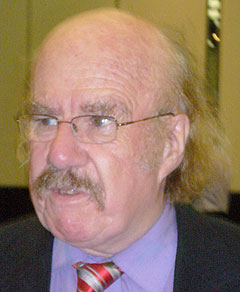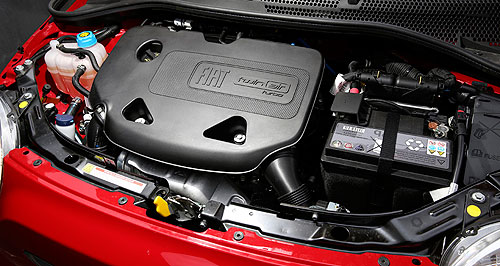Make / Model Search
News - General News - TechnologyCar-makers closing in on the most efficient engineIn the air: Professor Harry Watson has praised the technology behind the Fiat two-cylinder TwinAir engine. Achieving maximum efficiency will require small engines, big technology by 203016 Mar 2015 By IAN PORTER CAR-MAKERS are closing in on the maximum efficiency internal combustion engine, but achieving the last available improvements will require some expensive technology, according to a leading researcher and academic. Fiat’s tiny two-cylinder TwinAir unit and Volvo’s turbocharged triple are amongst the most efficient petrol engines currently on the market, according to Professor Harry Watson, retired head of the Mechanical Engineering Department at Melbourne University. However, he said they would need to be paired with electric motors if the industry is to get near the theoretical maximum efficiency of releasing 47 per cent of the energy contained in petrol, Professor Watson told the Asia Pacific Automotive Engineering Conference in Melbourne. Professor Watson said that, by 2030, he expected a typical D-segment sedan – A Mercedes-Benz E-Class or Ford Falcon-sized vehicle – would be able to achieve fuel consumption of 2.5 litres per 100 kilometres on the combined cycle. “When I first got involved in engine research (in the 1970s), consumption was around 12.8L/100kms,” he said. “Consumption of 2.5 litres would be a reduction of 80 per cent and I think that’s a really fantastic example of what engineering can do.” To get close to the theoretical maximum efficiency, engineers would have to combine several technologies, although a couple of steps may be deemed too expensive, Professor Watson warned. “The vehicle of 2030 is going to have a small capacity stratified-charge injection engine. A small engine is good for idle fuel consumption and just-off idle fuel consumption. “The engine will run at lower speeds, it will have increased cylinder size with fewer cylinders. So a 600cc cylinder capacity will be preferable to 200cc.” While there have been many engines in the past of 1.0-litre capacity or less, with four cylinders, Professor Watson said that more cylinders just created more friction. “Research shows that in urban test cycles, friction inside the engine absorbs 40 per cent of the work produced by the engine.” The biggest causes of friction were pistons and bearings, so the fewer pistons an engine has, the less friction it will have causing losses, he said. This is also a reason why engines should work at lower speeds, along with the fact that the Atkinson cycle, as used on the Camry Hybrid internal combustion engine, gives better combustion. In the Atkinson cycle, using special valve timing, the power stroke is longer than the compression stroke. This allows the engine to garner more of the energy created by combustion before the exhaust port opens, promoting fuel efficiency. “The Atkinson cycle has a lower peak combustion temperature and gives a larger work output. It is going to be a very important and emerging technology.” Professor Watson said slower engine speeds created a problem in the sense that a turbocharger, which works to improve fuel efficiency, does not work as well at low speeds. There were two ways around this, he said. First, turbochargers with variable vanes – already in production on some vehicles – can help the turbocharger work at low speeds. The alternative is to use the current Formula One practice, where the axle of the turbine is not only used to drive the air-pumping turbine, but also used to generate electricity when it is spinning quickly. When the turbine is spinning slowly and acceleration is required, the generator can then be used as an electric motor, drawing electricity from the storage battery, to help spin up the turbine quickly to cut down turbo lag. A crucial element of the engine of 2030 will be the use of very lean fuel/air mixtures and high compression ratios.  Left: Melbourne University head of mechanical engineering Professor Harry Watson.Professor Watson said it is likely future engines will use a pre-chamber that ignites a standard air/fuel mixture, which then spreads to the main chamber, igniting a mixture so lean that a spark plug would not be able to ignite it. Left: Melbourne University head of mechanical engineering Professor Harry Watson.Professor Watson said it is likely future engines will use a pre-chamber that ignites a standard air/fuel mixture, which then spreads to the main chamber, igniting a mixture so lean that a spark plug would not be able to ignite it.This stratified charge is relatively easy to arrange these days with direct injection systems, he said. These injection systems can also help efficiency by keeping the mixture away from the cylinder walls, where it is even harder to ignite. He said work by a former student, Will Attard, when working for Mahle in Detroit, showed that fuel economy benefits from lean-burn engines could be between 12 and 20 per cent, while NOx is reduced to negligible levels. Variable valve timing, with all camshafts is also able to produce variable valve lift and period,but may prove too expensive. Professor Watson said that variable valve timing needed to go a step further if the necessary high compression ratios are to be viable. “Fiat, in my view has the best technology to manage high-compression ratios at the moment. The MultiAir hydraulic valve system achieves various cam lift profiles.” He said the ideal system would be to have a system where the cam lobe can actually rotate at a different speed to the camshaft, enabling longer periods between valve actuation. The only example he knew of that reached production was the MG TF. But he said it was extremely difficult to achieve as each cylinder needed to be driven independently, and it would require a very complex mechanism to do all four cylinders at the same time. The MG actually had cams driven from both ends, so it was driving two cylinders at each time, not individual cylinders. Although he believed the technology used in dual-shaft gearboxes could possibly be deployed on camshafts, he said the expense would make it impractical for most vehicles. As for the electric part of the drivetrain, Professor Watson suggested some manufacturers were making an error in the layout of their hybrid systems by designing them to operate in series with the internal combustion engine rather than parallel. “Our view is that parallel systems are the way to go. “Why do you want to put energy through an electric motor that has maybe 95 per cent efficiency going in and 95 per cent efficiency going out? You are maybe going to lose 10 per cent, all the time.” The other expensive technology that offered a rise in efficiency but would probably not make it into production was the production of oxygen-rich air before it entered the intake manifold. Using a filter to extract nitrogen from the air flow produces oxygen-rich air that enables more petrol to be used to create more power. In effect, it would allow engines to be smaller again for the same power output. “What you do is have a membrane here with air passing the membrane and you have suction on the inside of the membrane. The membrane is set up so that nitrogen molecules, which are larger, get left on the outside and oxygen enriched air occurs on the inside.” Professor Watson proved such a system works when he worked with BHP to improve the performance of the many diesel generating sets the company uses at its mine sites. “Because you have a lot more oxygen, you can have a much larger pressure ratio and a lot more Atkinson on the pressure stroke and still get a huge amount of energy.”“That is an interesting project to look at in the future.” So the efficient vehicle of the future will have a smaller engine, with relatively large pistons, a high compression ratio and plenty of technology controlling the engine’s aspiration and combustion. “What I expect to see in 2030 is a small three-cylinder internal combustion engine and multiple fuel injection to give a stratified charge,” he said. “There will be a turbocharger to grow power and all the external drives (pumps and fans) will be electrical. “Smart electric assist with energy recovery, a turbocharger to grow power, Atkinson cycle to improve low speed power and allow high compression ratios.”“The Atkinson cycle means dual variable cam timing, but can we afford the cost of variable valve cam lift and period?”  |
Click to shareGeneral News articlesResearch General News Motor industry news |









Facebook Twitter Instagram